Complete Solutions to Linked Comprehension Type Questions of chapter Chemical Thermodynamics and Thermochemistry of Class 12 book with complete answers and questions
| Class 12 | CHEMISTRY |
| Chapter | Chemical Thermodynamics and Thermochemistry |
| OP TANDON | Linked Comprehension Type Questions |
| Number Of Questions | 40 |
| Academic Year | 2023-24 |
Chemical reactions are invariable associated with the transfer of enery either in the form of heat or light. In the laboratory, heat energy I physical and chemical processes are measured with an instrument called caloriemter. Heat change in the process is calcualted as:
`q-msDeltaT," "s=`specific heat
`=cDeltaT," "c=` Heat capacity.
Heat of reaction at constant pressure is measured using bomb calorimeter.
`q_(V)=DeltaU=` Internal energy change
heat of reaction at constant pressure is measrued using simple or water calorimeter.
`q_(P)=DeltaH`
`q_(P)=q_(V)+PDeltaV`
`DeltaH=DeltaU+DeltanRT`
The amount of energy released during a chemical change depends on the physical state of reactants and products, te conditions of pressure, temperatrue and volume at which the reaction is carried out. the variation of heat of reaction with temperature and pressure is given by kirchhoff's equation:
`(DeltaH_(2)-DeltaH_(1))/(T_(2)-T_(1))=DeltaC_(P)," "(DeltaU_(2)-DeltaU_(1))/(T_(2)-T_(1))=DeltaC_(V)`.
Q. Matht eh List-I and List-II and select the answer from the given codes:
 View Solution
View SolutionChemical reactions are invariable associated with the transfer of enery either in the form of heat or light. In the laboratory, heat energy I physical and chemical processes are measured with an instrument called caloriemter. Heat change in the process is calcualted as:
`q-msDeltaT," "s=`specific heat
`=cDeltaT," "c=` Heat capacity.
Heat of reaction at constant pressure is measured using bomb calorimeter.
`q_(V)=DeltaU=` Internal energy change
heat of reaction at constant pressure is measrued using simple or water calorimeter.
`q_(P)=DeltaH`
`q_(P)=q_(V)+PDeltaV`
`DeltaH=DeltaU+DeltanRT`
The amount of energy released during a chemical change depends on the physical state of reactants and products, te conditions of pressure, temperatrue and volume at which the reaction is carried out. the variation of heat of reaction with temperature and pressure is given by kirchhoff's equation:
`(DeltaH_(2)-DeltaH_(1))/(T_(2)-T_(1))=DeltaC_(P)," "(DeltaU_(2)-DeltaU_(1))/(T_(2)-T_(1))=DeltaC_(V)`.
Q. The heat capacity of a bomb calorimeter is 500 J/K. When 0.1g of methane was burnt in this calorimeter, the temperature rose by `2^(@)C`. the value of `DeltaU` per mole will be:View SolutionChemical reactions are invariably associated with the transfter of energy either in the form of heat or light. In the laboratory, heat changes in physical and chemical processes are measured with an instrument called calorimeter. Heat change in the process is calculated as
`{:(q = ms DeltaT,,s ="Specific heat"),(=cDeltaT,,c ="Heat capacity"):}`
Heat of reaction at constant volume is measured using bomb calorimeter.
`q_(V) = DeltaU =` Internal energy change
Heat of reaction at constant pressure is measured using simple or water calorimeter.
`q_(p) = DeltaH`
`q_(p) = q_(V) +P DeltaV`
`DeltaH = DeltaU +DeltanRT`
. For which reaction will `DeltaH`=`DeltaU`? Assume each reaction is carried out in an open container.01:58View SolutionChemical reactions are invariable associated with the transfer of enery either in the form of heat or light. In the laboratory, heat energy I physical and chemical processes are measured with an instrument called caloriemter. Heat change in the process is calcualted as:
`q-msDeltaT," "s=`specific heat
`=cDeltaT," "c=` Heat capacity.
Heat of reaction at constant pressure is measured using bomb calorimeter.
`q_(V)=DeltaU=` Internal energy change
heat of reaction at constant pressure is measrued using simple or water calorimeter.
`q_(P)=DeltaH`
`q_(P)=q_(V)+PDeltaV`
`DeltaH=DeltaU+DeltanRT`
The amount of energy released during a chemical change depends on the physical state of reactants and products, te conditions of pressure, temperatrue and volume at which the reaction is carried out. the variation of heat of reaction with temperature and pressure is given by kirchhoff's equation:
`(DeltaH_(2)-DeltaH_(1))/(T_(2)-T_(1))=DeltaC_(P)," "(DeltaU_(2)-DeltaU_(1))/(T_(2)-T_(1))=DeltaC_(V)`.
Q.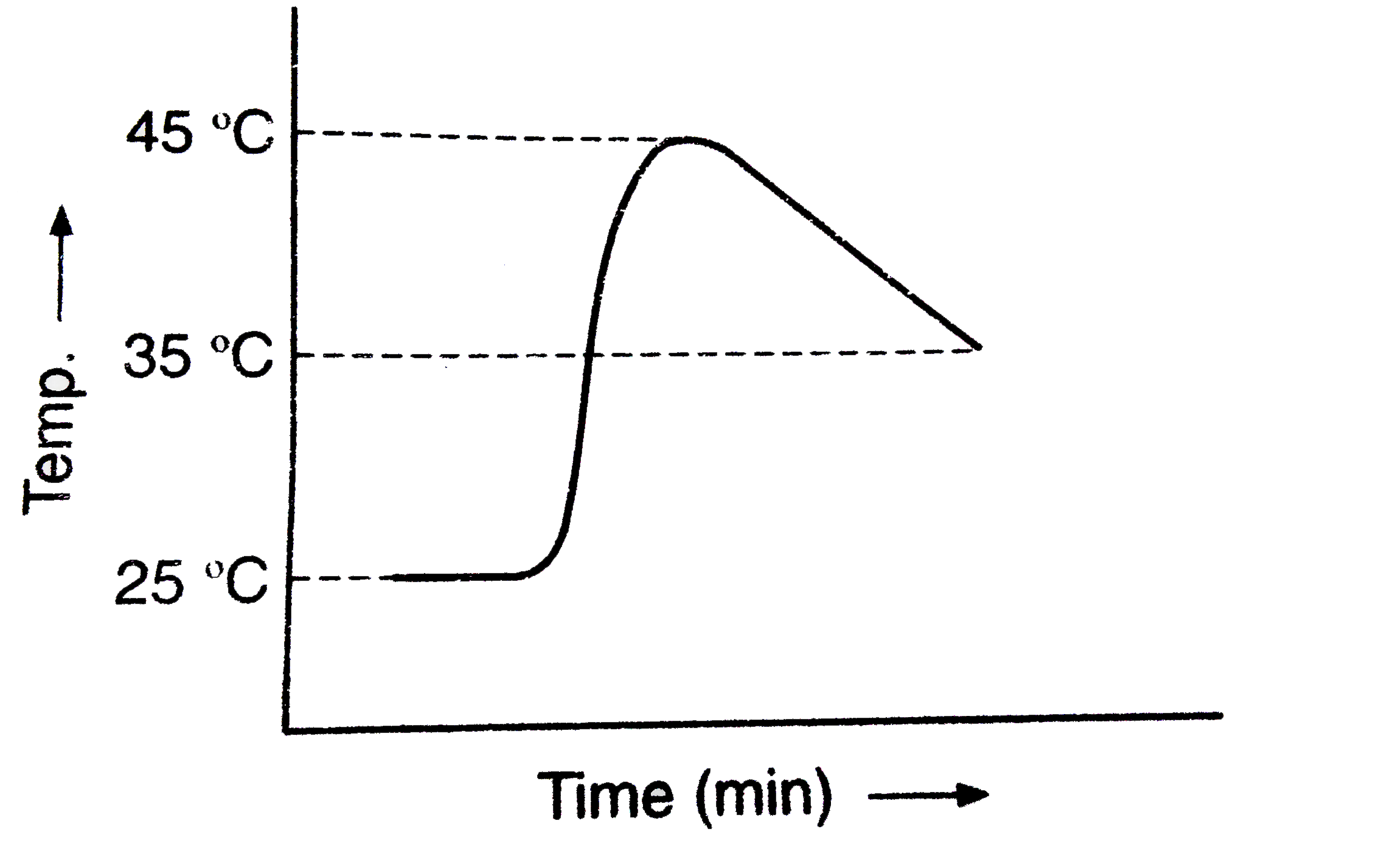
What value of `DeltaT` should be used for the calorimetry experiment that gives the following graphical result?View SolutionChemical reactions are invariable associated with the transfer of enery either in the form of heat or light. In the laboratory, heat energy I physical and chemical processes are measured with an instrument called caloriemter. Heat change in the process is calcualted as:
`q-msDeltaT," "s=`specific heat
`=cDeltaT," "c=` Heat capacity.
Heat of reaction at constant pressure is measured using bomb calorimeter.
`q_(V)=DeltaU=` Internal energy change
heat of reaction at constant pressure is measrued using simple or water calorimeter.
`q_(P)=DeltaH`
`q_(P)=q_(V)+PDeltaV`
`DeltaH=DeltaU+DeltanRT`
The amount of energy released during a chemical change depends on the physical state of reactants and products, te conditions of pressure, temperatrue and volume at which the reaction is carried out. the variation of heat of reaction with temperature and pressure is given by kirchhoff's equation:
`(DeltaH_(2)-DeltaH_(1))/(T_(2)-T_(1))=DeltaC_(P)," "(DeltaU_(2)-DeltaU_(1))/(T_(2)-T_(1))=DeltaC_(V)`.
Q. The enthalpy of fusion of ice is 6.02 kJ `mol^(-1)`. The heat capacity of water is `4.18Jg^(-1).^(@)C^(-1)`. What is the smallest number of ice cubes at `0^(@)C`, each containing one mole of water, that are needed to cool 500 g of liquid water from `20^(C)` to `0^(@)C`?View SolutionChemical reactions are invariable associated with the transfer of enery either in the form of heat or light. In the laboratory, heat energy I physical and chemical processes are measured with an instrument called caloriemter. Heat change in the process is calcualted as:
`q-msDeltaT," "s=`specific heat
`=cDeltaT," "c=` Heat capacity.
Heat of reaction at constant pressure is measured using bomb calorimeter.
`q_(V)=DeltaU=` Internal energy change
heat of reaction at constant pressure is measrued using simple or water calorimeter.
`q_(P)=DeltaH`
`q_(P)=q_(V)+PDeltaV`
`DeltaH=DeltaU+DeltanRT`
The amount of energy released during a chemical change depends on the physical state of reactants and products, te conditions of pressure, temperatrue and volume at which the reaction is carried out. the variation of heat of reaction with temperature and pressure is given by kirchhoff's equation:
`(DeltaH_(2)-DeltaH_(1))/(T_(2)-T_(1))=DeltaC_(P)," "(DeltaU_(2)-DeltaU_(1))/(T_(2)-T_(1))=DeltaC_(V)`.
Q. The enthalpy change `(DeltaH)` for the reaction,
`N_(2)(g)+3H_(2)(g)to2NH_2(g)`
is -91.38 kJ at 298 K. The nternal energy change `DeltaU` at 298K is:View SolutionChemical reactions are invariable associated with the transfer of enery either in the form of heat or light. In the laboratory, heat energy I physical and chemical processes are measured with an instrument called caloriemter. Heat change in the process is calcualted as:
`q-msDeltaT," "s=`specific heat
`=cDeltaT," "c=` Heat capacity.
Heat of reaction at constant pressure is measured using bomb calorimeter.
`q_(V)=DeltaU=` Internal energy change
heat of reaction at constant pressure is measrued using simple or water calorimeter.
`q_(P)=DeltaH`
`q_(P)=q_(V)+PDeltaV`
`DeltaH=DeltaU+DeltanRT`
The amount of energy released during a chemical change depends on the physical state of reactants and products, te conditions of pressure, temperatrue and volume at which the reaction is carried out. the variation of heat of reaction with temperature and pressure is given by kirchhoff's equation:
`(DeltaH_(2)-DeltaH_(1))/(T_(2)-T_(1))=DeltaC_(P)," "(DeltaU_(2)-DeltaU_(1))/(T_(2)-T_(1))=DeltaC_(V)`.
Q. The specific heats of `I_(2)` in vapour and solid states are 0.031 and 0.055 cal/g respectively. The heat of sublimation of iodine at `200^(@)C` is 6.096 kcal `mol^(-1)`. the heat of sublimation of iodine at `250^(@)C` will be:View SolutionBond energies can be obtained by using the following relation: `DeltaH (reaction) = sum`Bond energy of bonds, broken in the reactants `-sum` Bond energy fo bonds, formed in the products
Bond enegry depends on three factors:
a. Greater is the bond length, lesser is the bond enegry.
b. Bond energy increases with the bond multiplicity.
c. Bond enegry increases with electronegativity difference between the bonding atoms.
Arrange `N -H, O - H`, and `F -H` bonds in teh decreasing order of bond enegry.03:23View SolutionBond energies can be obtained by using the following relation: `DeltaH (reaction) = sum`Bond energy of bonds, broken in the reactants `-sum` Bond energy fo bonds, formed in the products
Bond enegry depends on three factors:
a. Greater is the bond length, lesser is the bond enegry.
b. Bond energy increases with the bond multiplicity.
c. Bond enegry increases with electronegativity difference between the bonding atoms.
Bond enegry of differene halogen molecules will lie in the sequences03:43View SolutionBond energies can be obtained by using the following relation: `DeltaH (reaction) = sum`Bond energy of bonds, broken in the reactants `-sum` Bond energy fo bonds, formed in the products
Bond enegry depends on three factors:
a. Greater is the bond length, lesser is the bond enegry.
b. Bond energy increases with the bond multiplicity.
c. Bond enegry increases with electronegativity difference between the bonding atoms.
Which among the following sequences is correct about the bond enegry of `C -C, C=C` and `C -= C` bonds?01:54View SolutionBond energies can be obtained by using the following relation: `DeltaH (reaction) = sum`Bond energy of bonds, broken in the reactants `-sum` Bond energy fo bonds, formed in the products
Bond enegry depends on three factors:
a. Greater is the bond length, lesser is the bond enegry.
b. Bond energy increases with the bond multiplicity.
c. Bond enegry increases with electronegativity difference between the bonding atoms.
In `CH_(4)` molecule, which of the following statement is correct about the `C -H` bond enegry?02:50View SolutionBond energies can be obtained by using the following relation: `DeltaH (reaction) = sum`Bond energy of bonds, broken in the reactants `-sum` Bond energy fo bonds, formed in the products
Bond enegry depends on three factors:
a. Greater is the bond length, lesser is the bond enegry.
b. Bond energy increases with the bond multiplicity.
c. Bond enegry increases with electronegativity difference between the bonding atoms.
Use the bond enegries to estimate `DeltaH` for this reaction:
`H_(2)(g) +O_(2)(g) rarr H_(2)O_(2)(g)`
`{:("Bond","Bond energy"),(H-H,436 kJ mol^(-1)),(O-O,142 kJ mol^(-1)),(O=O, 499kJ mol^(-1)),(H-O,460kJ mol^(-1)):}`03:31View SolutionBond energies can be obtained by using the following relation: `DeltaH (reaction) = sum`Bond energy of bonds, broken in the reactants `-sum` Bond energy fo bonds, formed in the products
Bond enegry depends on three factors:
a. Greater is the bond length, lesser is the bond enegry.
b. Bond energy increases with the bond multiplicity.
c. Bond enegry increases with electronegativity difference between the bonding atoms.
The heat of formation of `NO` from its elements is `+90 kJ mol^(-1)`, What is the approximate bond dissociation enegry of the bond in `NO`?
`BE_(N=N) = 941 kJ mol^(-1) BE_(O=O) = 499 kJ mol^(-1)`04:03View SolutionA change in the free energy of a system at constant temperature and pressure will be:
`Delta_(sys)G = Delta_(sys)H -T Delta_(sys)S`
At constant temperature and pressure
`Delta_(sys) G lt 0` (spontaneous)
`Delta_(sys)G = 0` (equilibrium)
`Delta_(sys)G gt 0` (non-spontaneous)
The free enegry for a reaction having `DeltaH = 31400 cal, DeltaS = 32 cal K^(-1) mol^(-1) at 1000^(@)C` is01:53View SolutionA change in the free energy of a system at constant temperature and pressure will be:
`Delta_(sys)G = Delta_(sys)H -T Delta_(sys)S`
At constant temperature and pressure
`Delta_(sys) G lt 0` (spontaneous)
`Delta_(sys)G = 0` (equilibrium)
`Delta_(sys)G gt 0` (non-spontaneous)
For a spontaneous reaction `DeltaG`, equilibrium `K` and `E_(cell)^(Theta)` will be, respectively05:15View SolutionA change in the free energy of a system at constant temperature and pressure will be:
`Delta_(sys)G = Delta_(sys)H -T Delta_(sys)S`
At constant temperature and pressure
`Delta_(sys) G lt 0` (spontaneous)
`Delta_(sys)G = 0` (equilibrium)
`Delta_(sys)G gt 0` (non-spontaneous)
For a system in equilibrium, `DeltaG = 0`, under conditions of constant01:32View SolutionThe change in Gibbs free energy `(DeltaG)` of the system along provides a criterion for the spontaneity of a process at constant temperature and pressure. A change in the free energy of a system at constant temperature and pressure will be:
`DeltaG_("system")=DeltaH_("system")-TDeltaS_("system")`
At constant temperature and pressure:
`DeltaG_("system")lt0` (Spontaneous)
`DeltaG_("system")=0` (equilibrium)
`DeltaG_("system")gt0` (non-spontaneous)
Free energy is related to the equilibrium constant as:
`DeltaG^(@)=2.303RTlog_(10)K_(e)`.
Q. If b oth `DeltaH and DeltaS` are negative, the reaction will be spontaneous:View SolutionThe change in Gibbs free energy `(DeltaG)` of the system along provides a criterion for the spontaneity of a process at constant temperature and pressure. A change in the free energy of a system at constant temperature and pressure will be:
`DeltaG_("system")=DeltaH_("system")-TDeltaS_("system")`
At constant temperature and pressure:
`DeltaG_("system")lt0` (Spontaneous)
`DeltaG_("system")=0` (equilibrium)
`DeltaG_("system")gt0` (non-spontaneous)
Free energy is related to the equilibrium constant as:
`DeltaG^(@)=2.303RTlog_(10)K_(e)`.
Q. A reaction has positive values of `DeltaH and DeltaS`. From this you can deduce that the reaction:View SolutionThe change in Gibbs free energy `(DeltaG)` of the system along provides a criterion for the spontaneity of a process at constant temperature and pressure. A change in the free energy of a system at constant temperature and pressure will be:
`DeltaG_("system")=DeltaH_("system")-TDeltaS_("system")`
At constant temperature and pressure:
`DeltaG_("system")lt0` (Spontaneous)
`DeltaG_("system")=0` (equilibrium)
`DeltaG_("system")gt0` (non-spontaneous)
Free energy is related to the equilibrium constant as:
`DeltaG^(@)=2.303RTlog_(10)K_(e)`.
Q. For a reaction to be spontaneous at all temperature.View Solution3 moles of `CO_(2)` gas expands isothermally against external pressure of 1 bar. Volume increases from 10 L to 30 L respectively. The system is in thermal contact of surroundings at temperature `15^(@)C`. Entropy change in isotehrmal process is:
`DeltaS=2.303nR" log "((V_(2))/(V_(1)))`.
Q. If `CO_(2)` behaves like an ideal gas, then entropy change of system `(DeltaS_("system"))` will be:View Solution3 moles of `CO_(2)` gas expands isothermally against external pressure of 1 bar. Volume increases from 10 L to 30 L respectively. The system is in thermal contact of surroundings at temperature `15^(@)C`. Entropy change in isotehrmal process is:
`DeltaS=2.303nR" log "((V_(2))/(V_(1)))`.
Q. Select the correct relation:View SolutionWhen `100mL` of `1.0M HCl` was mixed with `100 mL` of `1.0 M NaOH` in an insulated beaker at constant pressure, a temperature increase of `5.7^(@)C` was measured for the beaker and its contents (Expt.1). Because the enthalpy of neutralisation of a strong acid with a strong base is constant `(-57.0kJmol^(-1))` this experiment couldbe used to measure the calorimeter constant. In a second experiment (Expt.2), `100mL` of `2.0M` acetic acid `K_(a)=2.0xx10^(-5))` was mixed with `100mL` of `1.0M NaOH` (under identical conditions to Expt. 1) where a temperature rise of `5.6^(@)C` was measured.
Enthalpy of dissociation (in `kJ mol^(-1)`) of acetic acid obtained from the Expt. 2 is08:51View SolutionWhen `100mL` of `1.0M HCl` was mixed with `100 mL` of `1.0 M NaOH` in an insulated beaker at constant pressure, a temperature increase of `5.7^(@)C` was measured for the beaker and its contents (Expt.1). Because the enthalpy of neutralisation of a strong acid with a strong base is constant `(-57.0kJmol^(-1))` this experiment couldbe used to measure the calorimeter constant. In a second experiment (Expt.2), `100mL` of `2.0M` acetic acid `K_(a)=2.0xx10^(-5))` was mixed with `100mL` of `1.0M NaOH` (under identical conditions to Expt. 1) where a temperature rise of `5.6^(@)C` was measured.
The `pH` of the solution after Expt. 2 ils06:44View Solution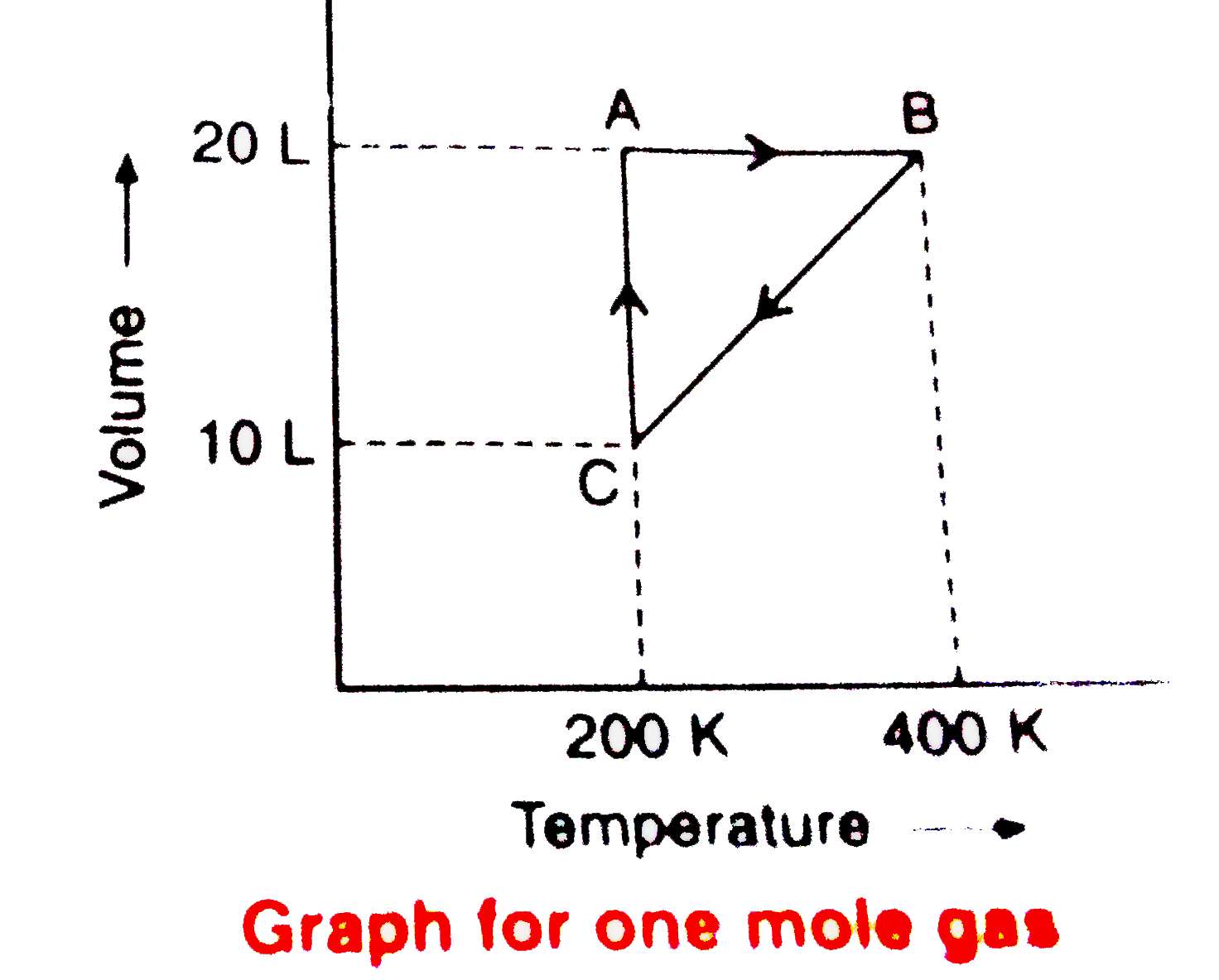
Process, `AtoB` represent:View Solution
The pressure at `C` is02:02View Solution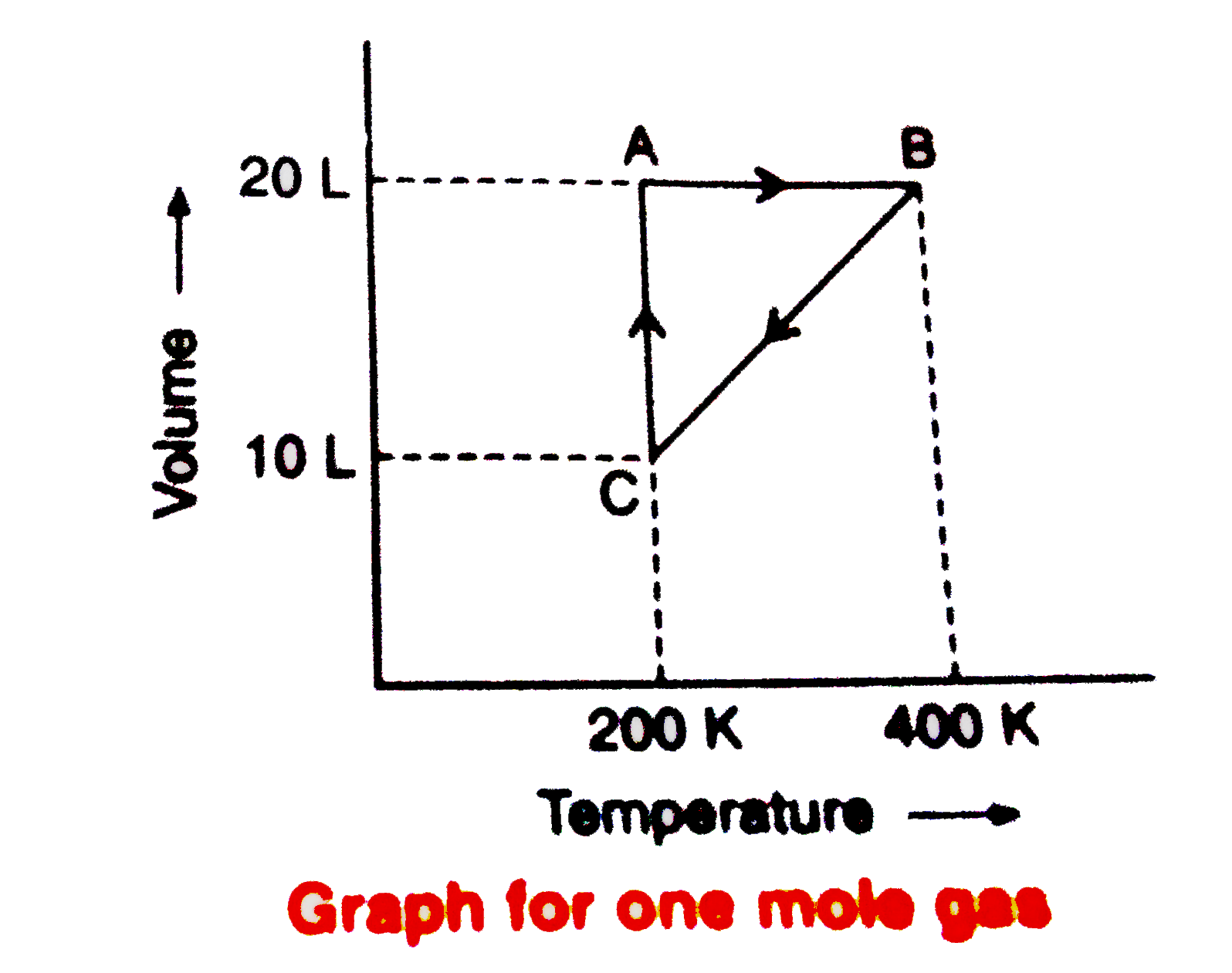
Q. Work doen in the process `C to A` is:02:36View Solution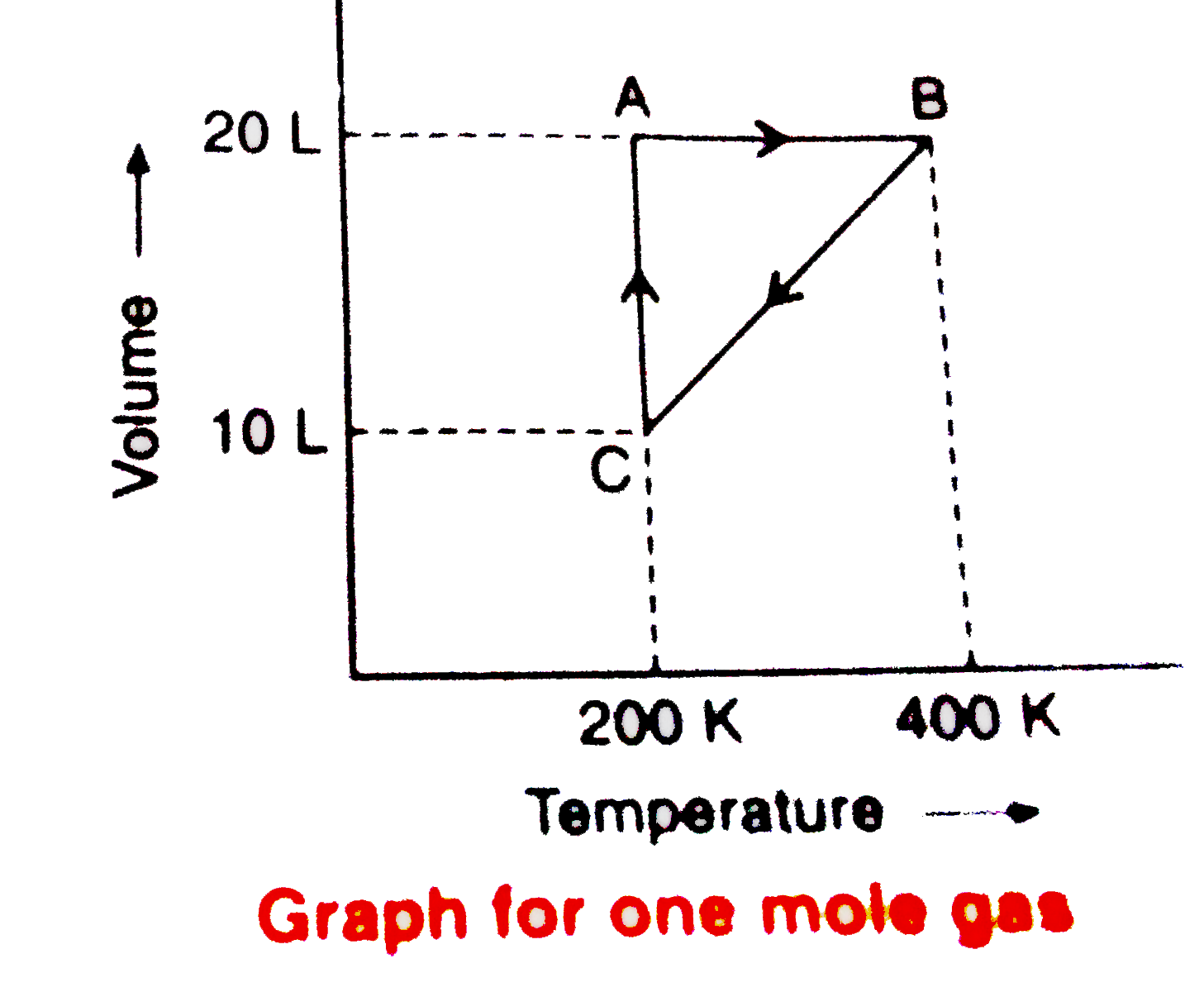
Q. The process which occurs in going from `BtoC` is:View Solution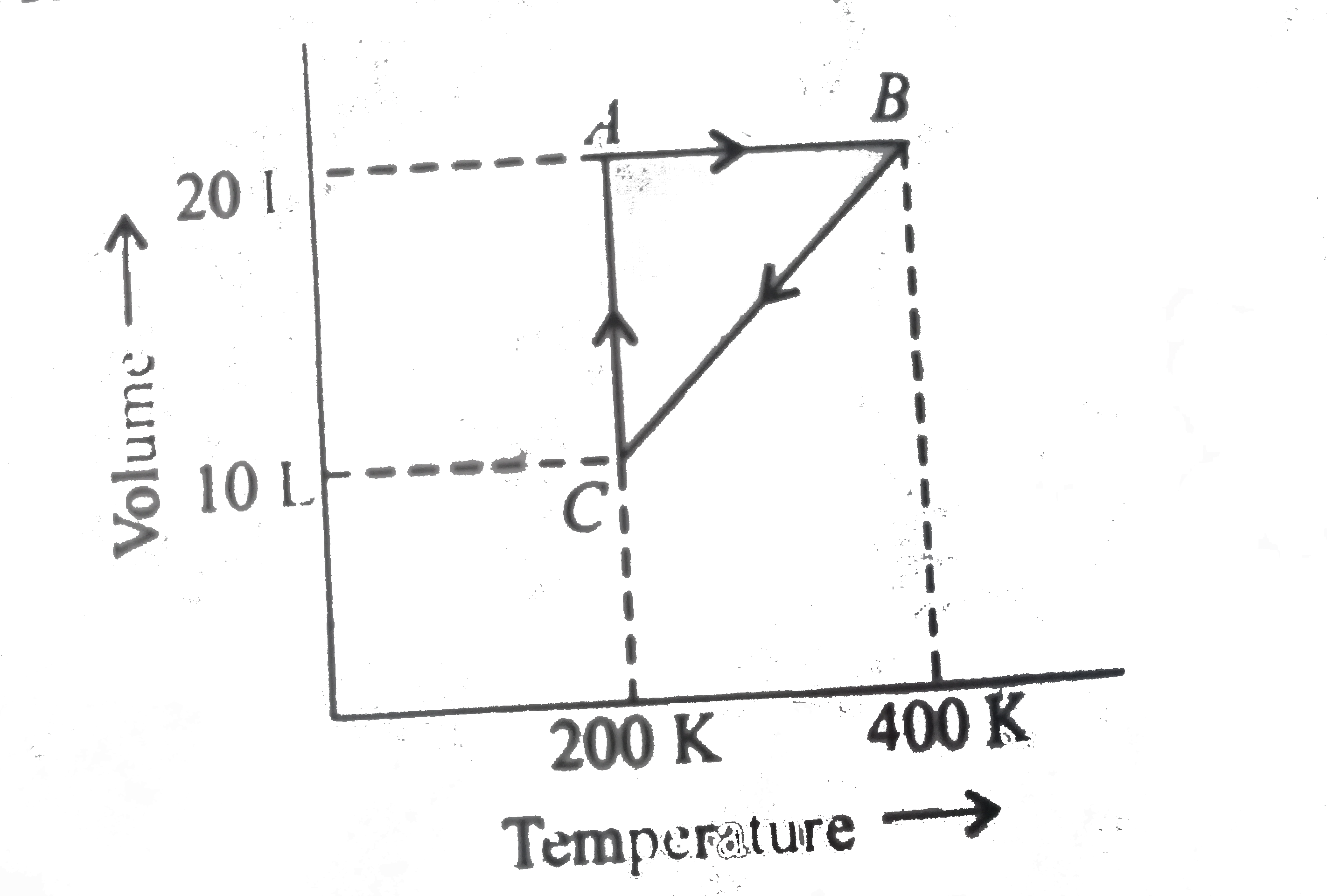
The pressures at `A` and `B` in the atmosphere are, respectively,02:33View SolutionThe thermodynamic property that measures the extent of molecular disorder is called entropy. Entropy change of phase transformation can be calculated using Trouton's formula `(DeltaS = DeltaH//T)`. In the reversible adiabatic process, however, `DeltaS` will be zero. the rise in temperature in isobaric and isochoric conditions is found to increase the randomness or entropy of the system.
`DeltaS = 2.303 C log (T_(1)//T_(2))`
The entropy change in an adiabatic process is02:16View SolutionThe thermodynamic property that measuers the extent of molecular disorder is called entropy. The direction of a spontaneous process for which the energy is constant is always the one that increases the molecular disorder. Entropy change of phase transformation can be calculated using Trouton's furmula `(DeltaS=(DeltaH)/(T))`. In the reversible adiabatic process, however, `DeltaS` will be zero. The rise in temperature in isobaric and isochoric conditions is found to increase the randomness or entropy of the system.
Q. `DeltaS=2.303C" log "(T_(1)//T_(2))`
`C=C_(P)` or `C_(V)`.
Q. If water in an insulated vessel at `-10^(@)C`, suddenly freezes, the entropy change of the system will be:View SolutionThe thermodynamic property that measuers the extent of molecular disorder is called entropy. The direction of a spontaneous process for which the energy is constant is always the one that increases the molecular disorder. Entropy change of phase transformation can be calculated using Trouton's furmula `(DeltaS=(DeltaH)/(T))`. In the reversible adiabatic process, however, `DeltaS` will be zero. The rise in temperature in isobaric and isochoric conditions is found to increase the randomness or entropy of the system.
Q. `DeltaS=2.303C" log "(T_(1)//T_(2))`
`C=C_(P)` or `C_(V)`.
Q. The melting point of a solid is 300 K and its latent heat of fusion is 600 cal `mol^(-1)`. the entropy change for the fusion of 1 mole of the solid (in cal `K^(-1)`) at the same temperature would beView SolutionThe thermodynamic property that measures the extent of molecular disorder is called entropy. Entropy change of phase transformation can be calculated using Trouton's formula `(DeltaS = DeltaH//T)`. In the reversible adiabatic process, however, `DeltaS` will be zero. the rise in temperature in isobaric and isochoric conditions is found to increase the randomness or entropy of the system.
`DeltaS = 2.303 C log (T_(1)//T_(2))`
For which of the following cases, `DeltaS = (DeltaH)/(T)`?02:59View SolutionThe thermodynamic property that measures the extent of molecular disorder is called entropy. Entropy change of phase transformation can be calculated using Trouton's formula `(DeltaS = DeltaH//T)`. In the reversible adiabatic process, however, `DeltaS` will be zero. the rise in temperature in isobaric and isochoric conditions is found to increase the randomness or entropy of the system.
`DeltaS = 2.303 C log (T_(1)//T_(2))`
When `1` mol of an ideal gas is compressed to half of its volume, its temperature becomes half. Then the change in entropy `(DeltaS)` would be03:40View SolutionThe pressure-volume of various thermodynamic process is shown in graphs:
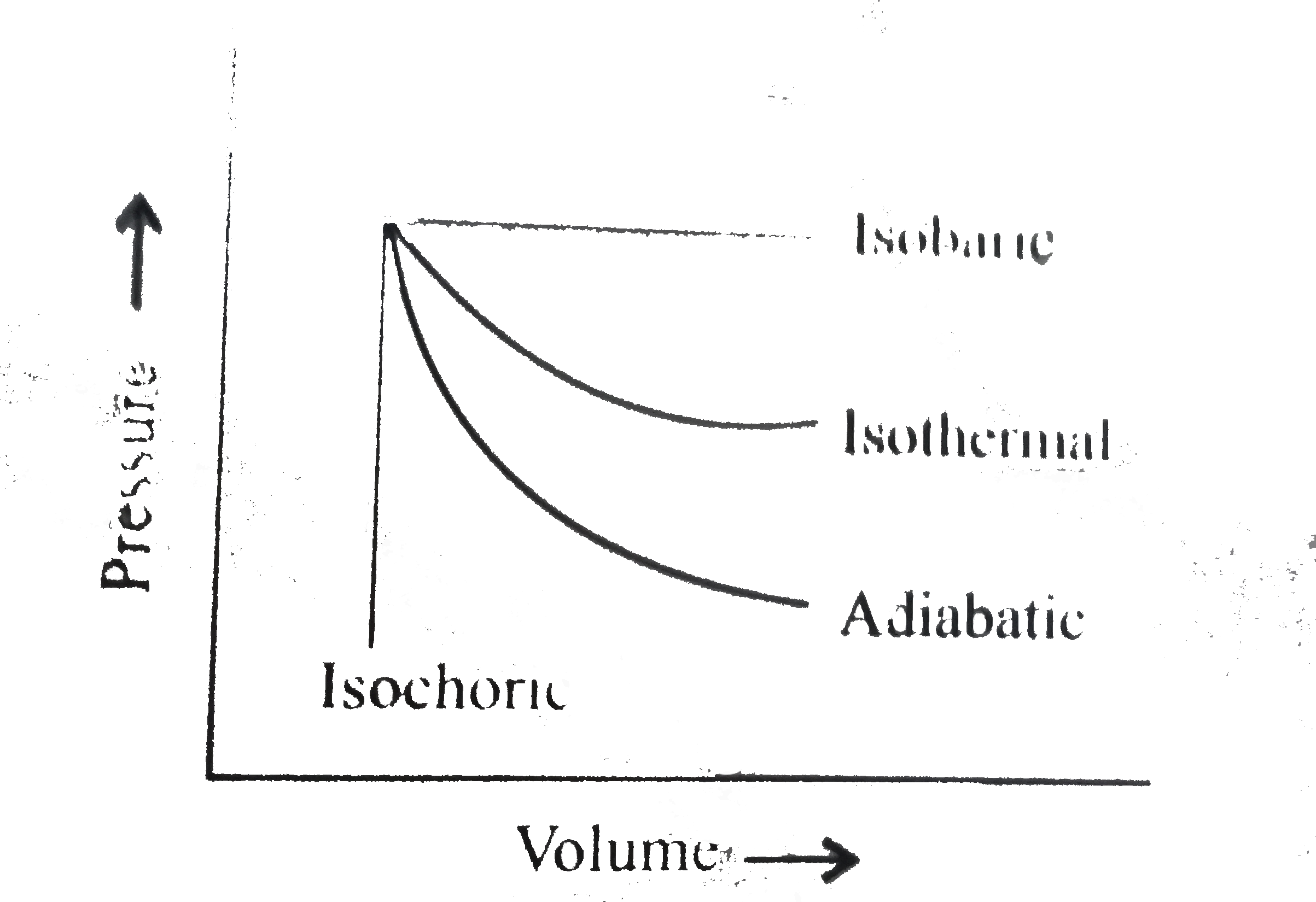
Work is the mole of transference of energy. It has been observed that reversible work done by the system is the maximum obtainable work.
`w_(rev) gt w_(irr)`
The works of isothermal and adiabatic processes are different from each other.
`w_("isothermal reversible") = 2.303 nRT log_(10) ((V_(2))/(V_(1)))`
`= 2.303 nRT log_(10)((P_(2))/(P_(1)))`
`w_("adiabatic reversible") = C_(V) (T_(1)-T_(2))`
If `w_(1),w_(2),w_(3)` and `w_(4)` are work done in isothermal, adiabatic, isobaric, and isochoric reversible processes, respectively then the correct sequence (for expansion) would be04:49View SolutionThe pressure-volume of various thermodynamic process is shown in graphs:
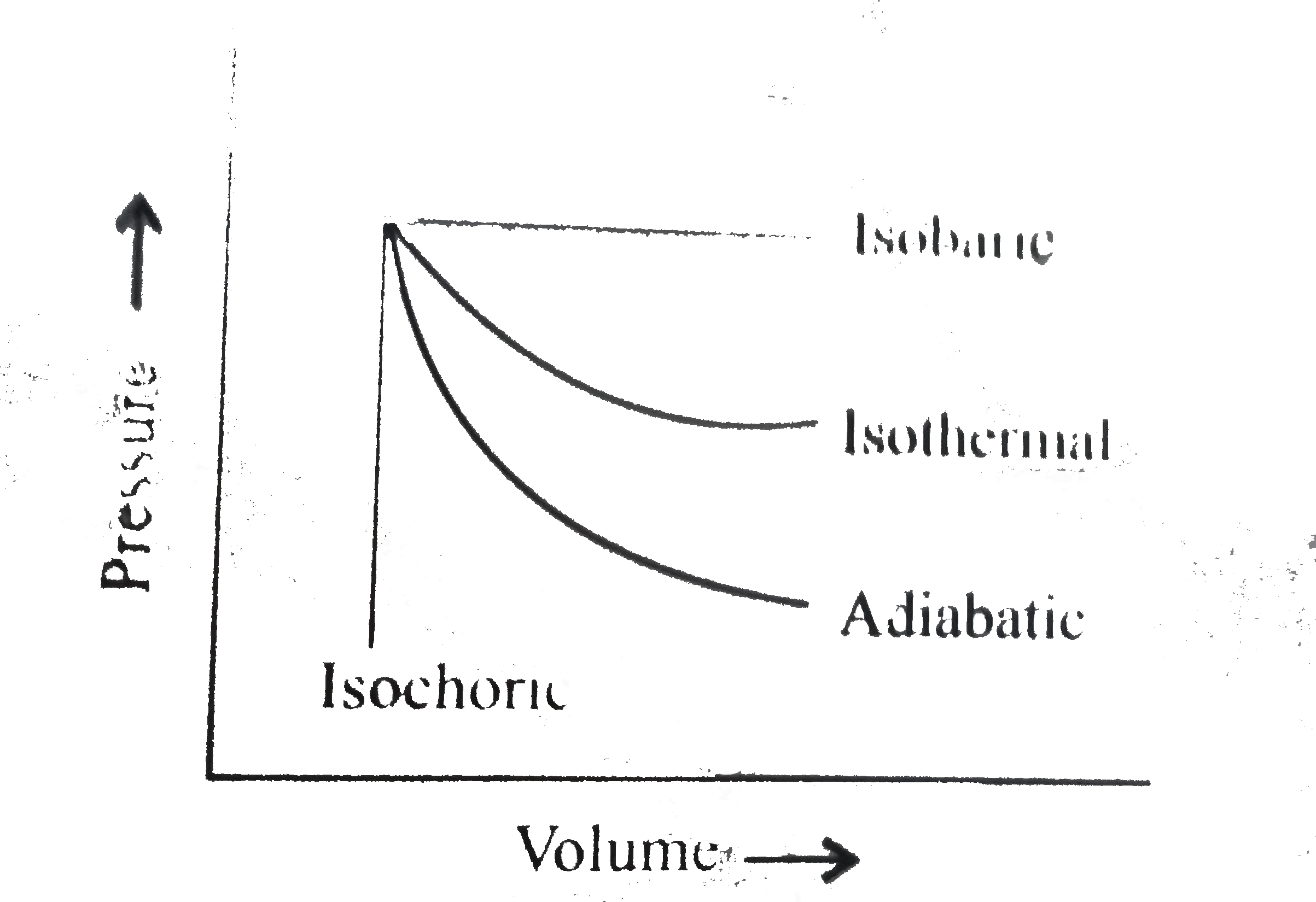
Work is the mole of transference of energy. It has been observed that reversible work done by the system is the maximum obtainable work.
`w_(rev) gt w_(irr)`
The works of isothermal and adiabatic processes are different from each other.
`w_("isothermal reversible") = 2.303 nRT log_(10) ((V_(2))/(V_(1)))`
`= 2.303 nRT log_(10)((P_(2))/(P_(1)))`
`w_("adiabatic reversible") = C_(V) (T_(1)-T_(2))`
A thermodynamic system goes in a cyclic process as represented in the following `P -V` diagram:
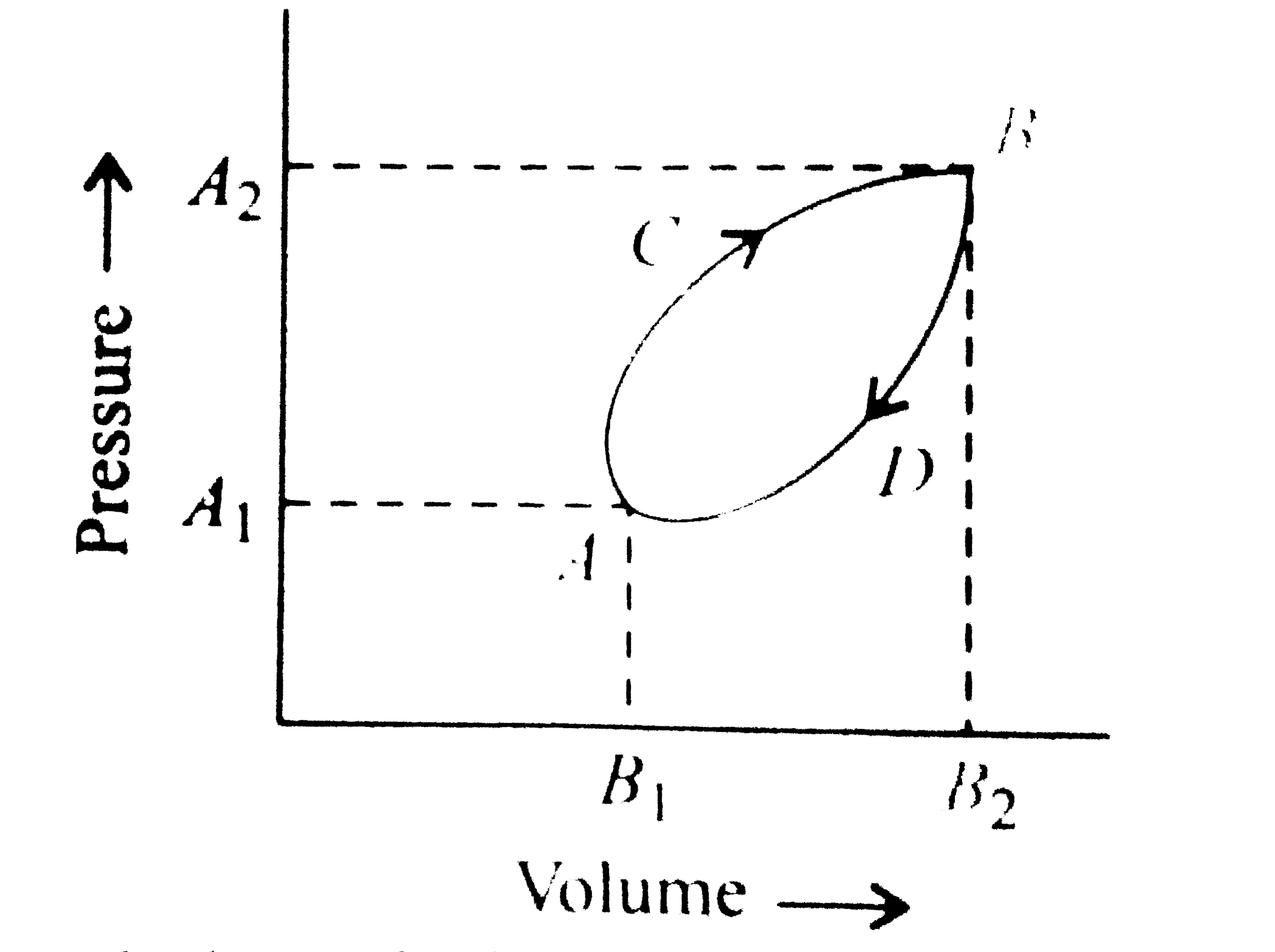
The net work done during the complete cycle is given by the area01:30View SolutionThe pressure-volume of various thermodynamic process is shown in graphs:
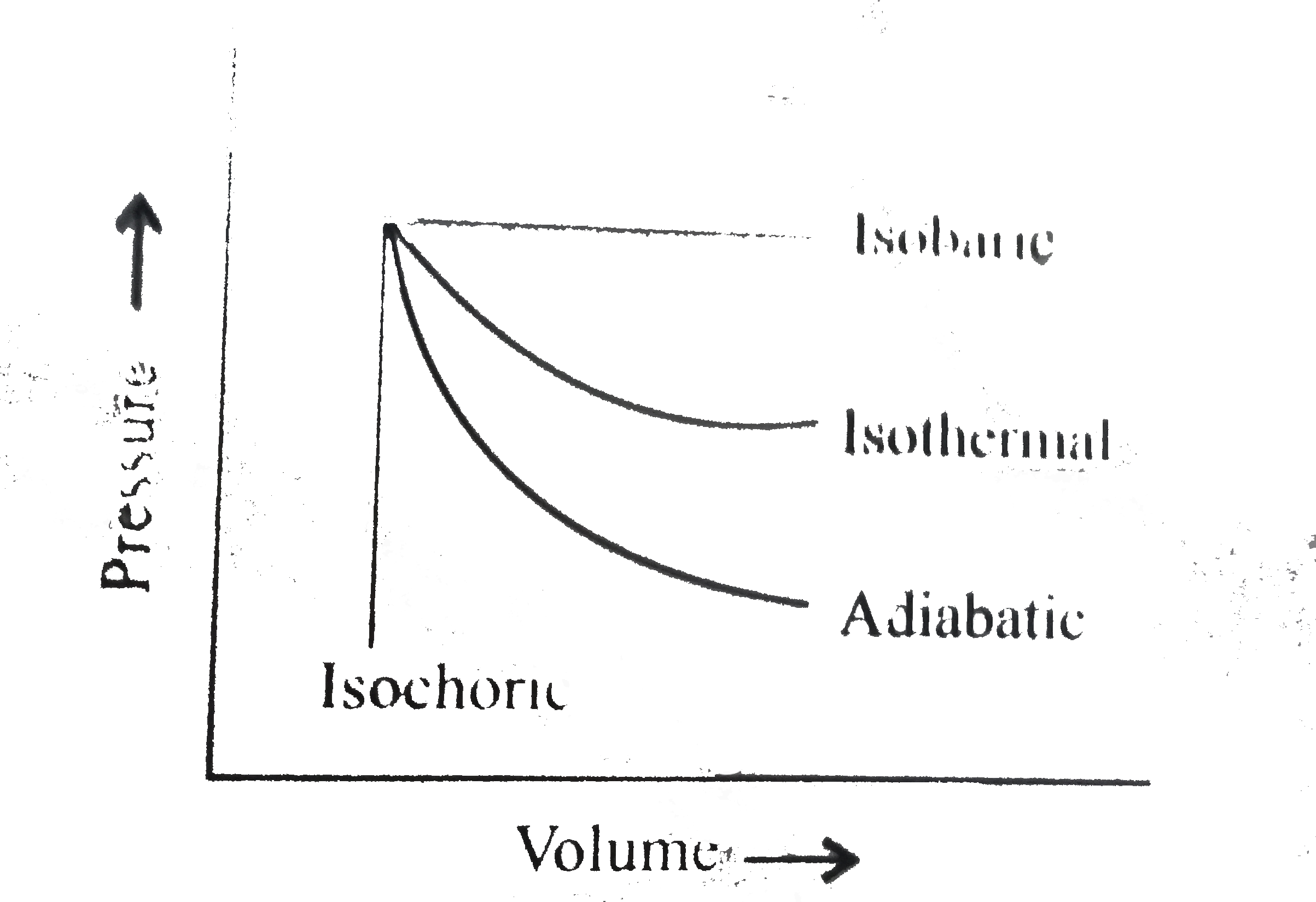
Work is the mole of transference of energy. It has been observed that reversible work done by the system is the maximum obtainable work.
`w_(rev) gt w_(irr)`
The works of isothermal and adiabatic processes are different from each other.
`w_("isothermal reversible") = 2.303 nRT log_(10) ((V_(2))/(V_(1)))`
`= 2.303 nRT log_(10)((P_(2))/(P_(1)))`
`w_("adiabatic reversible") = C_(V) (T_(1)-T_(2))`
`P-V` plots for two gases during adiabatic processes are given in the given figure:
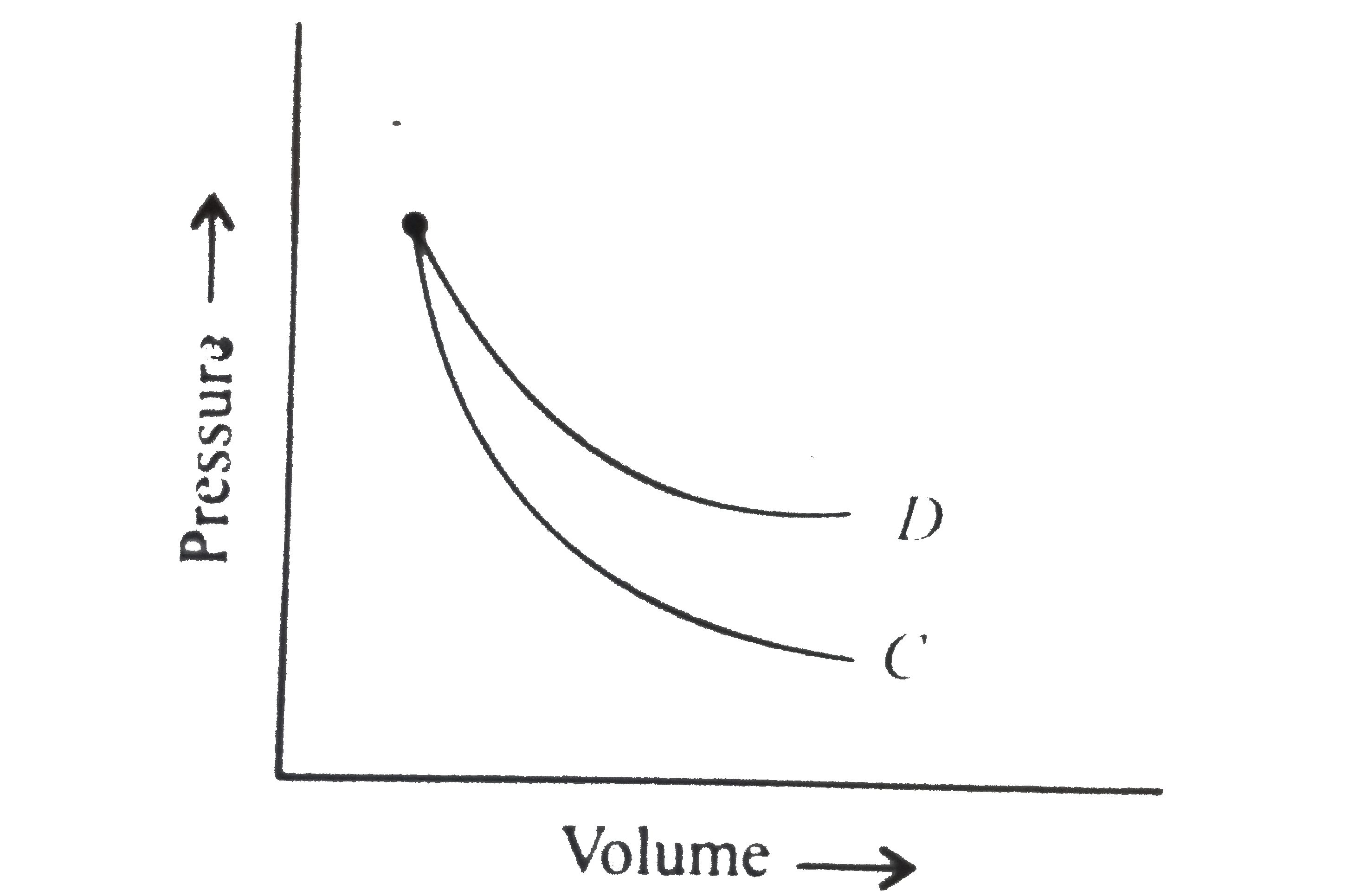
Plot `D` and Plot `C` should correspond to06:44View SolutionThe pressure-volume of varies thermodynamic process is shown in graphs:
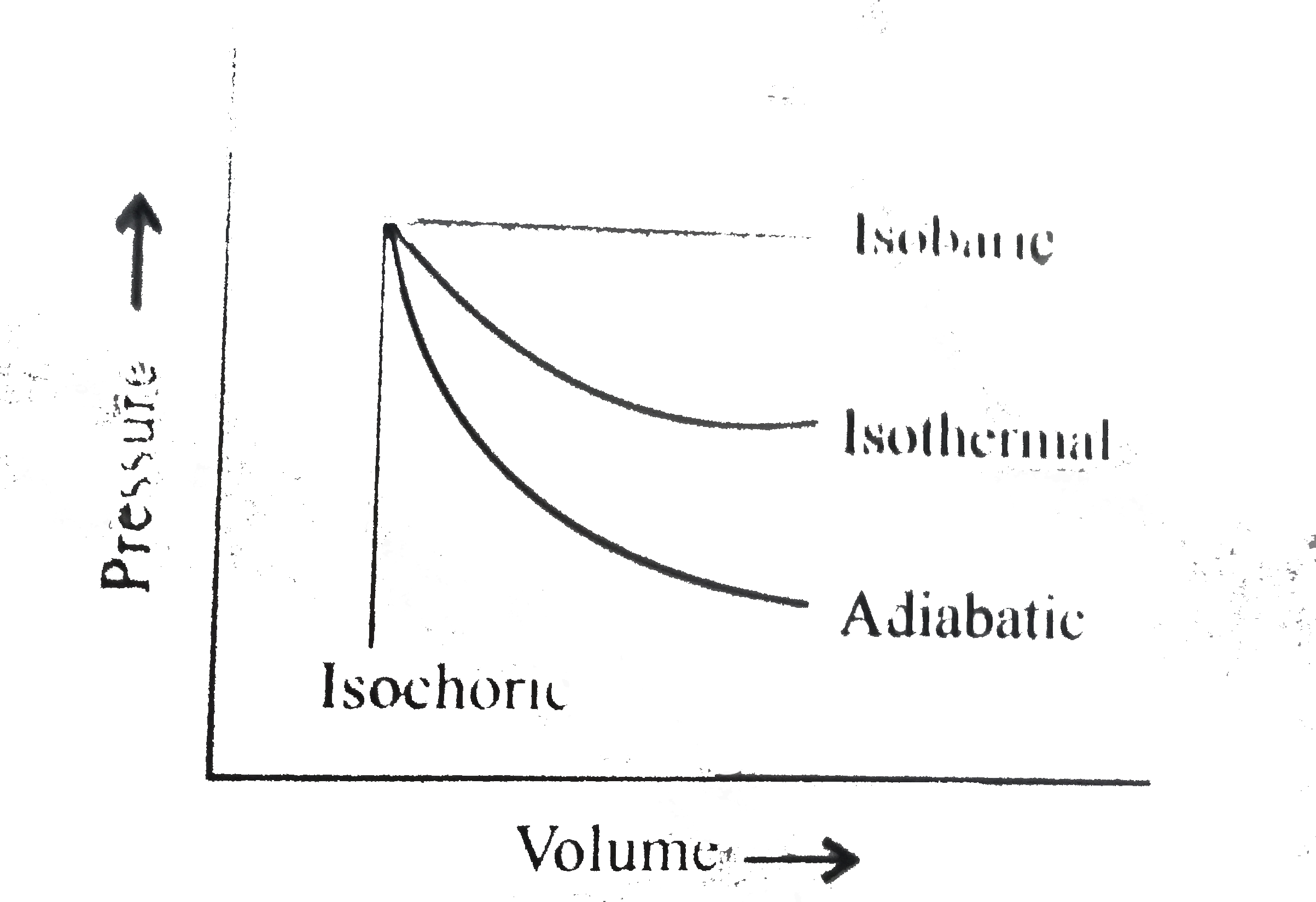
Work is the mole of transference of energy. It has been observed that reversible work done by the system is the maximum obtainable work.
`w_(rev) gt w_(irr)`
The works of isothermal and adiabatic processes are different from each other.
`w_("isothermal reversible") = 2.303 nRT log_(10) ((V_(2))/(V_(1)))`
`= 2.303 nRT log_(10)((P_(2))/(P_(1)))`
`w_("adiabatic reversible") = C_(V) (T_(1)-T_(2))`
The `q` value and work done in isothermal reversible expansion of one mole of an ideal gas from initial pressure of `1` bar to final pressure of `0.1` bar at constant temperature `273K` are:04:20View SolutionWork is the mode of transference of energy. If the system involves gaseous substance and there is difference of pressure between system and surroundings, such a work is referred to as pressure - volume work `(W_(PV)= -P_(ext)DeltaV)`. It has been observed that reversible work done by the system is the maximum obtainable work. `w_(rev) gt w_(ir r)`
The works of isothermal and adiabatic processes are different from each other. for isothermal reversible proces,
`W_("isothermal reversible")=2.303 nRT log_(10) (V_(2)/V_(1))`
`W_("adiabatic reversible")=C_(V) (T_(1)-T_(2))`
Calculate work done when 1 mole of an ideal gas is expanded reversibly from 20 L to 40 L at a constant temperature of 300 K.01:23View SolutionA fixed mass `m` of a gas is subjected to transformation of state: `K` to L to `M` and back to `K` as shown in the figure.
The succeeding operations that enabel this transformation of state are
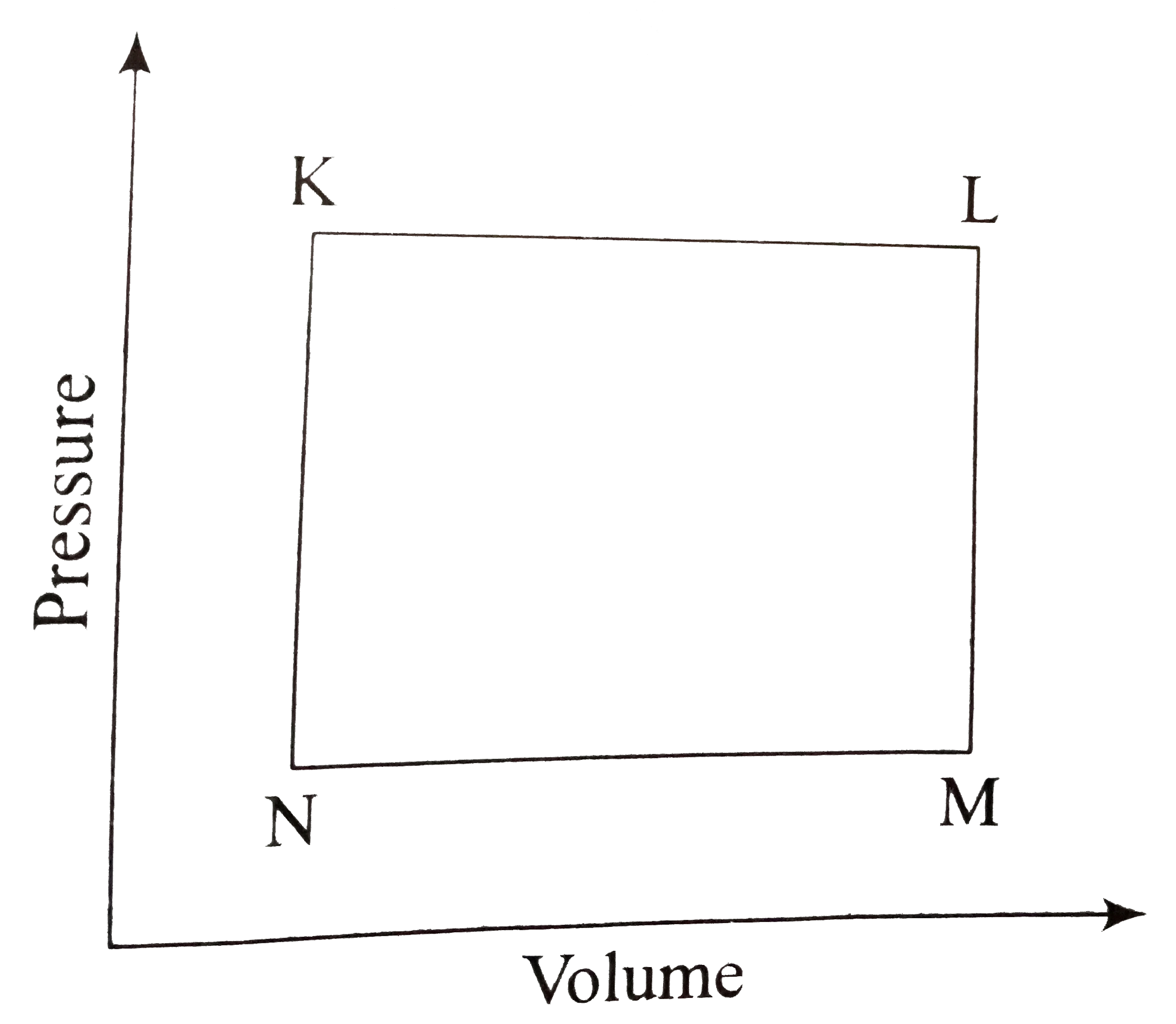 09:20View Solution
09:20View SolutionA fixed mass m of a gas is subjected to transfromation of states from K to L to M and back to K as shown in the figure.

The pair of isochoric processes among the transfromation of states is01:24View Solution
Linked Comprehension Type Questions questions and complete solutions for chapter Chemical Thermodynamics and Thermochemistry of G.R. BATHLA & SONS CHEMISTRY (HINGLISH) of Class 12
All Exercises from OP TANDON Class 12 CHEMISTRY Chemical Thermodynamics and Thermochemistry
- Assertion Reason Type Question
- Assertion Reason Type Question Set-2
- Example
- Illustrations of Objective Questions
- Integer Type
- Linked Comprehension Type Questions
- Matric Matching Type Questions
- Miscellaneous Numerical Examples
- Objective Question Level B
- Objective Question Level B Set II
- Objective Question Level-A
- Practice problems
- Self Assessment
- Self Assessment (Assertion Reason)
- Self Assessment (Integer type).
- Self Assessment (Matrix Type)
- Self Assessment (Multiple Choice)
- Set 2
- Solved Example
